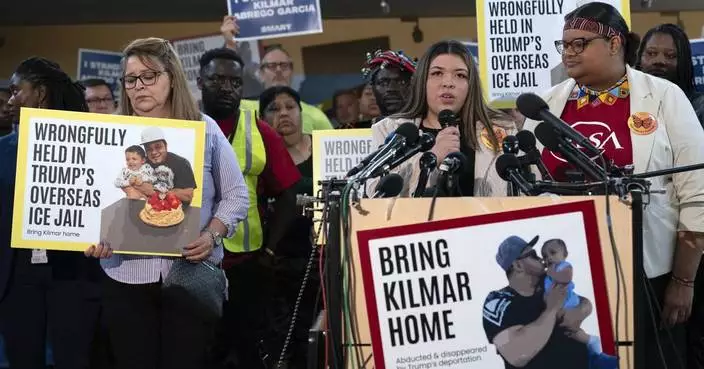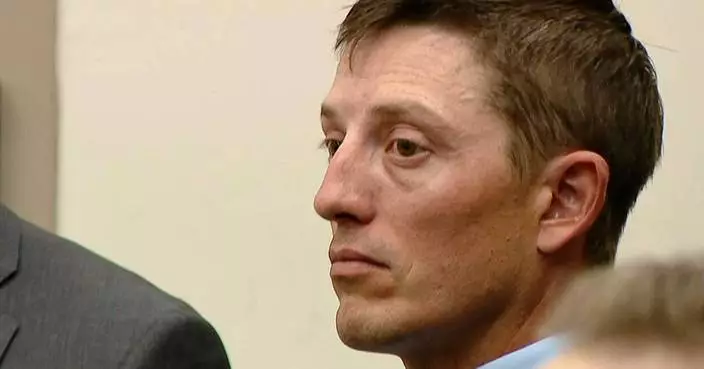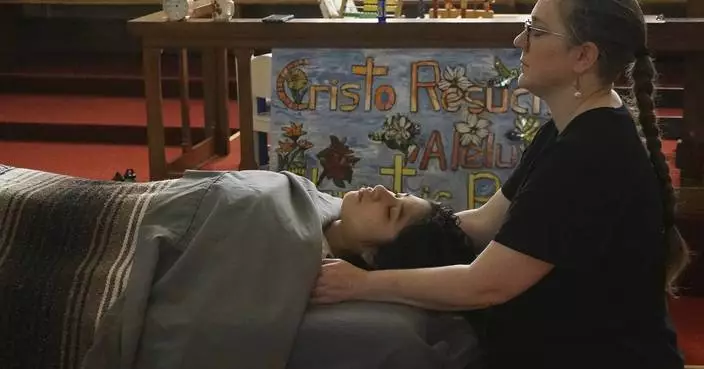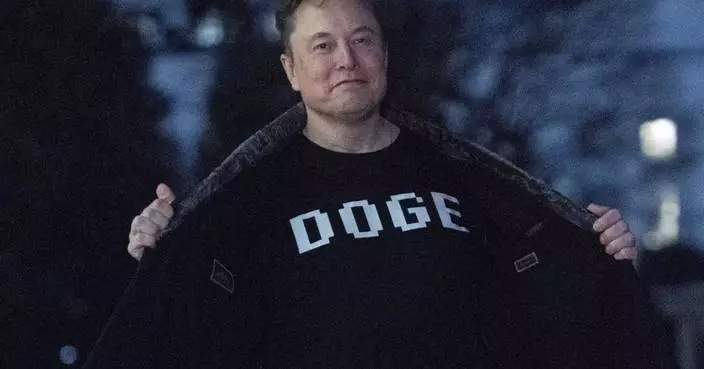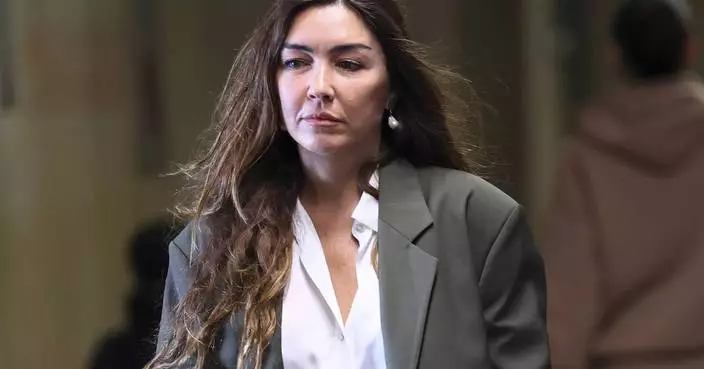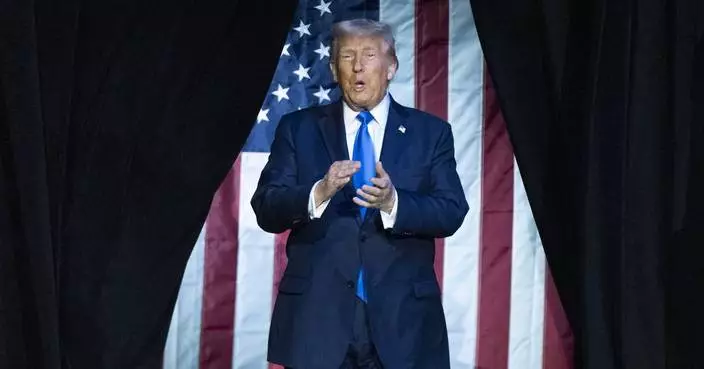PHILADELPHIA (AP) — Take a look at Ticketmaster or most secondary market websites this week and there are plenty of seats still available at various stadiums for this year's Club World Cup in the United States.
No, not the World Cup. The “FIFA Club World Cup 2025.”
Click to Gallery
FIFA President Gianni Infantino poses with a Philadelphia Eagles NFL football jersey while next to the trophy at a welcoming event for the 2025 FIFA Club World Cup soccer tournament, Thursday, April 10, 2025, in Philadelphia. (AP Photo/Chris Szagola)
Fans pose with the trophy at a welcoming event for the 2025 FIFA Club World Cup soccer tournament, Thursday, April 10, 2025, in Philadelphia. (AP Photo/Chris Szagola)
Philadelphia Eagles NFL football player A.J. Brown takes a selfie as he poses with the trophy at a welcoming event for the 2025 FIFA Club World Cup soccer tournament, Thursday, April 10, 2025, in Philadelphia. (AP Photo/Chris Szagola)
FIFA President Gianni Infantino looks on at a welcoming event for the 2025 FIFA Club World Cup soccer tournament, Thursday, April 10, 2025, in Philadelphia. (AP Photo/Chris Szagola)
FIFA President Gianni Infantino speaks to the media at a welcoming event for the 2025 FIFA Club World Cup soccer tournament, Thursday, April 10, 2025, in Philadelphia. (AP Photo/Chris Szagola)
FIFA President Gianni Infantino speaks to the media at a welcoming event for the 2025 FIFA Club World Cup soccer tournament, Thursday, April 10, 2025, in Philadelphia. (AP Photo/Chris Szagola)
FIFA President Gianni Infantino, left, and Philadelphia Eagles NFL football player A.J. Brown, left, pose with an Eagles jersey during a welcoming event for the 2025 FIFA Club World Cup soccer tournament, Thursday, April 10, 2025, in Philadelphia. (Jose F. Moreno/The Philadelphia Inquirer via AP)
FIFA President Gianni Infantino, right, talks with Philadelphia Eagles NFL football player A.J. Brown, left, at a welcoming event for the 2025 FIFA Club World Cup soccer tournament, Thursday, April 10, 2025, in Philadelphia. (AP Photo/Chris Szagola)
FIFA President Gianni Infantino speaks to the media at a welcoming event for the 2025 FIFA Club World Cup soccer tournament, Thursday, April 10, 2025, in Philadelphia. (AP Photo/Chris Szagola)
It's an international soccer tournament designed to bring together 32 professional teams from around the world with matches in 11 American cities, including Philadelphia. Lincoln Financial Field will host six group stage matches, a round-of-16 match, and, per FIFA, “a highly anticipated quarterfinals match” on July 4.
In fact, while FIFA President Gianni Infantino promoted the tournament — a pair of Lombardi Trophies for the Philadelphia Eagles behind him — he alternated between Spanish and English and at one point turned to American reporters to say, “Buy tickets. There are still a few available.”
Whether you call it soccer or call it football, the sport is coming to the U.S. this year, in part to promote next year's real deal World Cup. Next year's tournament, with 48 national teams for the first time, also will be played at various NFL stadiums, as well as in Canada and Mexico. FIFA plans to spread the wealth of staging the warm-up event, pledging on Thursday $1 million to each of the 11 cities that will host Club World Cup matches this summer.
“Everyone thinks that the country winning their own national or continental competition is the best in the world,” Infantino said, referring to tournaments like the Champions League and Copa Libertadores. “But that's actually not the case. So we decided to create a real World Cup for teams.”
This year's revamped and expanded tournament is set to start on June 15 and run through July 13, with the final set for New Jersey’s MetLife Stadium — also the site of the 2026 World Cup final. FIFA announced earlier this year a $1 billion broadcast deal with DAZN for broadcast rights to this summer's Club World Cup.
Two American teams are confirmed for this year's tournament: Inter Miami and the Seattle Sounders.
Twelve teams from Europe will be included in the Club World Cup: Atletico Madrid, Bayern Munich, Benfica, Borussia Dortmund, Chelsea, Inter Milan, Juventus, Manchester City, Paris Saint-Germain, Porto, Real Madrid and Salzburg.
Other teams that have qualified are Boca Juniors, Botafogo, Flamengo, Fluminense, Palmeiras and River Plate from South America; Leon, Monterrey and Pachuca from North America; Al Ahly, Esperance, Mamelodi Sundowns and Wydad from Africa; Al-Hilal, Al Ain, Ulsan and Urawa from Asia; and Auckland City from Oceania.
“I don't have any concerns about ticket sales,” Infantino said. “We'll have full stadiums in America. If in America you fill soccer stadiums for friendly games, then when you come with a World Cup and the best players to win a competition ... we'll have to promote it, we'll have to present it, we'll have to explain it to the people. That's what we are doing. But it's a celebration of soccer and the stadiums will be full and fans will be coming from all over the world.”
The current U.S. political climate could be enough to scare off fans from traveling overseas for the games. Infantino met with President Donald Trump last month in the Oval Office to hype this event — and next year's true main event.
“The world loves America, whatever some might say,” Infantino said.
Infantino said he received assurances from the White House that any foreign fans would be in good hands during their time in the United States. The FIFA president met this week with U.S. Attorney General Pam Bondi and FBI Director Kash Patel at the FIFA office in Miami to map out a security plan and any potential issues with international fans traveling to the U.S. on visas.
“It's absolutely crucial that we have this collaboration,” Infantino said. “This never would have been possible some years ago with the image that FIFA had. We came back a long way. Today, we work in a clear way, in a transparent way, in an ethical way. We'll bring the world to the United States of America. These are the guarantees the United States government signed at the time of the bidding, and reconfirmed of course. The world will be welcomed.”
Eagles wide receiver and Super Bowl champion AJ Brown hit the Linc to promote the event but noted he never played much soccer beyond the FIFA videogame. He said he planned to attend his first soccer matches this summer — a first-time fan, just like FIFA hoped would attend the summer extravaganza.
“I always heard great things,” Brown said.
AP soccer: https://apnews.com/hub/soccer

FIFA President Gianni Infantino poses with a Philadelphia Eagles NFL football jersey while next to the trophy at a welcoming event for the 2025 FIFA Club World Cup soccer tournament, Thursday, April 10, 2025, in Philadelphia. (AP Photo/Chris Szagola)

Fans pose with the trophy at a welcoming event for the 2025 FIFA Club World Cup soccer tournament, Thursday, April 10, 2025, in Philadelphia. (AP Photo/Chris Szagola)

Philadelphia Eagles NFL football player A.J. Brown takes a selfie as he poses with the trophy at a welcoming event for the 2025 FIFA Club World Cup soccer tournament, Thursday, April 10, 2025, in Philadelphia. (AP Photo/Chris Szagola)

FIFA President Gianni Infantino looks on at a welcoming event for the 2025 FIFA Club World Cup soccer tournament, Thursday, April 10, 2025, in Philadelphia. (AP Photo/Chris Szagola)

FIFA President Gianni Infantino speaks to the media at a welcoming event for the 2025 FIFA Club World Cup soccer tournament, Thursday, April 10, 2025, in Philadelphia. (AP Photo/Chris Szagola)

FIFA President Gianni Infantino speaks to the media at a welcoming event for the 2025 FIFA Club World Cup soccer tournament, Thursday, April 10, 2025, in Philadelphia. (AP Photo/Chris Szagola)

FIFA President Gianni Infantino, left, and Philadelphia Eagles NFL football player A.J. Brown, left, pose with an Eagles jersey during a welcoming event for the 2025 FIFA Club World Cup soccer tournament, Thursday, April 10, 2025, in Philadelphia. (Jose F. Moreno/The Philadelphia Inquirer via AP)

FIFA President Gianni Infantino, right, talks with Philadelphia Eagles NFL football player A.J. Brown, left, at a welcoming event for the 2025 FIFA Club World Cup soccer tournament, Thursday, April 10, 2025, in Philadelphia. (AP Photo/Chris Szagola)

FIFA President Gianni Infantino speaks to the media at a welcoming event for the 2025 FIFA Club World Cup soccer tournament, Thursday, April 10, 2025, in Philadelphia. (AP Photo/Chris Szagola)
The nation's public broadcasting system — decades-long home to Big Bird, Ken Burns documentaries and “All Things Considered" — faces the biggest crisis in its nearly 60-year history with President Donald Trump's order to slash federal subsidies.
A court fight seems inevitable, with the heads of PBS, NPR and the Corporation for Public Broadcasting all suggesting Friday that Trump's order is illegal.
“We will vigorously defend our right to provide essential news, information and life-saving services to the American public,” said Katherine Maher, NPR's president and CEO. “We will challenge this executive order using all means available.” Her counterpart at PBS, Paula Kerger, said Trump's order was blatantly unlawful.
The public broadcasting system dates back to the late 1960s, devised as an educational and public service-oriented alternative to commercial broadcasters available at the time. In his order, Trump said the system has become politically biased and time has passed it by.
“Today the media landscape is filled with abundant, diverse and innovative news options,” the president said in his order, issued just before midnight Thursday. “Government funding of news media in this environment is not only outdated and unnecessary, but corrosive to the appearance of journalistic independence.”
Trump's order concentrates on news, and between PBS' “NewsHour” and a robust reporting corps at NPR, that's an important part of their operations. But public broadcasting also has entertainment programming, educational children's shows and Burns' historical documentaries.
PBS and NPR get about a half-billion dollars a year in public funding funneled through the private Corporation for Public Broadcasting. Roughly 70% of that goes directly to the 330 local PBS outlets and 246 NPR stations.
On average, PBS says 15% of its stations' budgets come from public funding. But there are wide variations; stations in larger markets usually get more money through philanthropy and fund drives, while smaller stations depend much more on the government.
Besides Trump's order, Congress has been considering future funding levels for the public broadcasters, and the Federal Communications Commission is questioning public broadcasting efforts at corporate underwriting, said Josh Shepperd, author of the 2023 book “Shadow of the New Deal: The Victory of Public Broadcasting.”
“It's a three-pronged effort that is frankly very smart in its institutional understanding,” Shepperd said. “They're not just going after programs that they don't like. They're going after the operations and the infrastructure that makes it possible to even air the programming.”
Trump's order instructs the CPB and other government agencies to “cease Federal funding” for PBS and National Public Radio and further requires that they work to root out indirect sources of public financing. Separate from the CPB grant, for example, PBS gets a grant from the U.S. Department of Education for programming that helps build the reading, math and science skills for children age 2 to 8, particularly in poor areas.
The administration's plan might not threaten your favorite program — Burns gets plenty of corporate and philanthropic support — but it may impact local programming and potential growth, Shepperd said.
Congressional Republicans aired some of their grievances about public broadcasting to Kerger and Maher at a public hearing in March. Such complaints have been common over the years, but the broadcasters have avoided funding cuts, in large part because members of Congress don't want to be seen as responsible if a station in their district shuts down. Who wants to be the public official who killed “Sesame Street”?
Also, public pressure from constituents is minimized because most Republicans don't watch PBS or listen to NPR, said Tim Graham, director of media analysis at the conservative Media Research Center. “I have this morning habit of listening to NPR on my commute,” Graham said. “I yell at the radio.”
For years, Graham's group has issued reports with examples of what it says is bias against conservatives. For example, during an 18-month period that ended last November, his researchers counted 162 examples of PBS journalists or contributors making reference labeling some politicians “far right” or some variation, with only six called “far left.”
He said he's not trying to shut down these stations, but resists them receiving public money.
“Let the people who listen to it do the funding,” Graham said.
At a board meeting Friday, CPB president and CEO Pat Harrison said her agency has taken bias concerns seriously. It has increased investments in fact-based local journalism, and provided a grant to NPR to make changes in its newsroom to address issues of bias.
The court fight over public broadcasting has already begun. The president earlier this week said he was firing three of the five remaining CPB board members — threatening its ability to do any work — and was immediately sued by the CPB to stop it.
The executive order is also the latest move by Trump and his administration to utilize federal powers to control or hamstring institutions whose actions or viewpoints he disagrees with — particularly those related to media.
Since taking office in January for a second term, Trump has ousted leaders, placed staff on administrative leave and cut off hundreds of millions of dollars in funding to artists, libraries, museums, theaters and others, through takeovers of the John F. Kennedy Center for the Performing Arts and the National Endowment for the Humanities. Trump has also pushed to withhold federal research and education funds from universities and punish law firms unless they agree to eliminate diversity programs and other measures he has found objectionable.
The move against PBS and NPR comes as Trump's administration works to dismantle the U.S. Agency for Global Media, including Voice of America and Radio Free Europe/Radio Liberty, which were designed to model independent news gathering globally in societies that restrict the press.
Those efforts have faced pushback from federal courts, which have ruled in some cases that the Trump administration may have overstepped its authority in holding back funds appropriated to the outlets by Congress.
AP Congressional Correspondent Lisa Mascaro contributed to this report. David Bauder writes about media for the AP. Follow him at http://x.com/dbauder and https://bsky.app/profile/dbauder.bsky.social
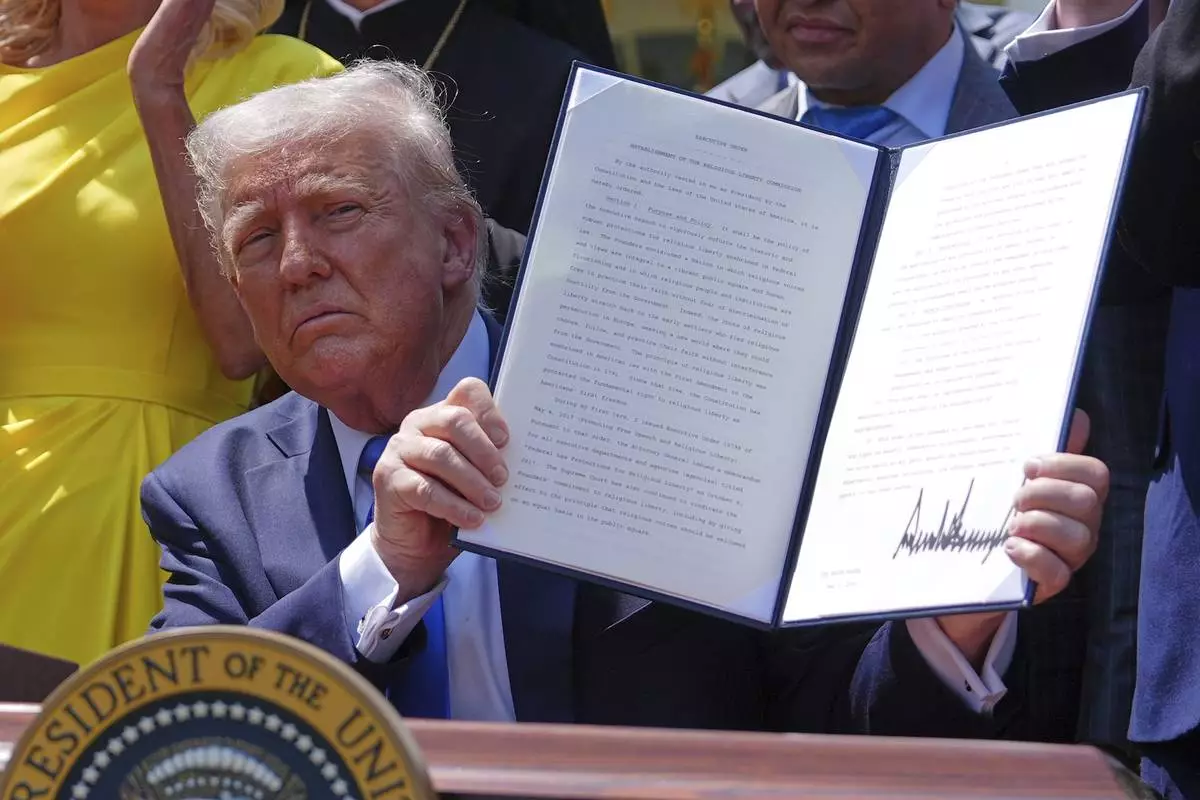
President Donald Trump holds up a signed executive order establishing the Religious Liberty Commission, during a National Day of Prayer event in the Rose Garden of the White House, Thursday, May 1, 2025, in Washington. (AP Photo/Evan Vucci)
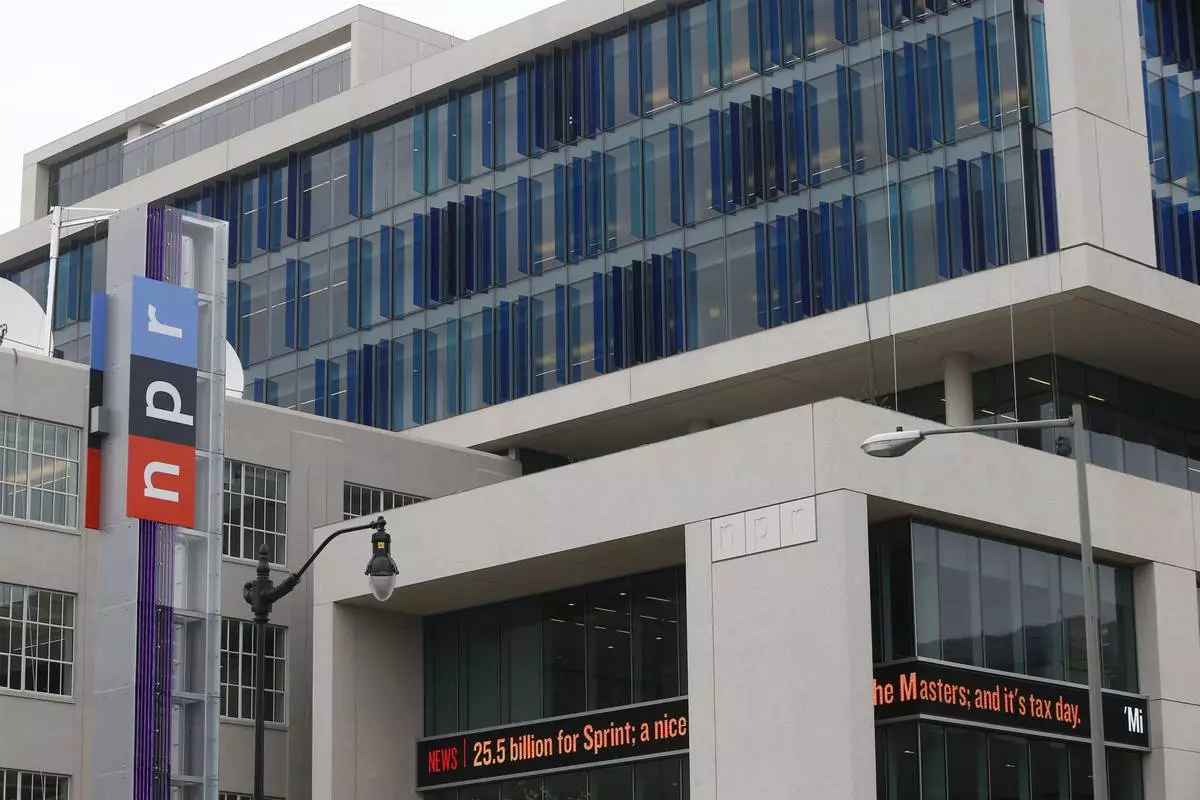
FILE - The headquarters for National Public Radio (NPR) is seen in Washington, April 15, 2013. AP Photo/Charles Dharapak, File)
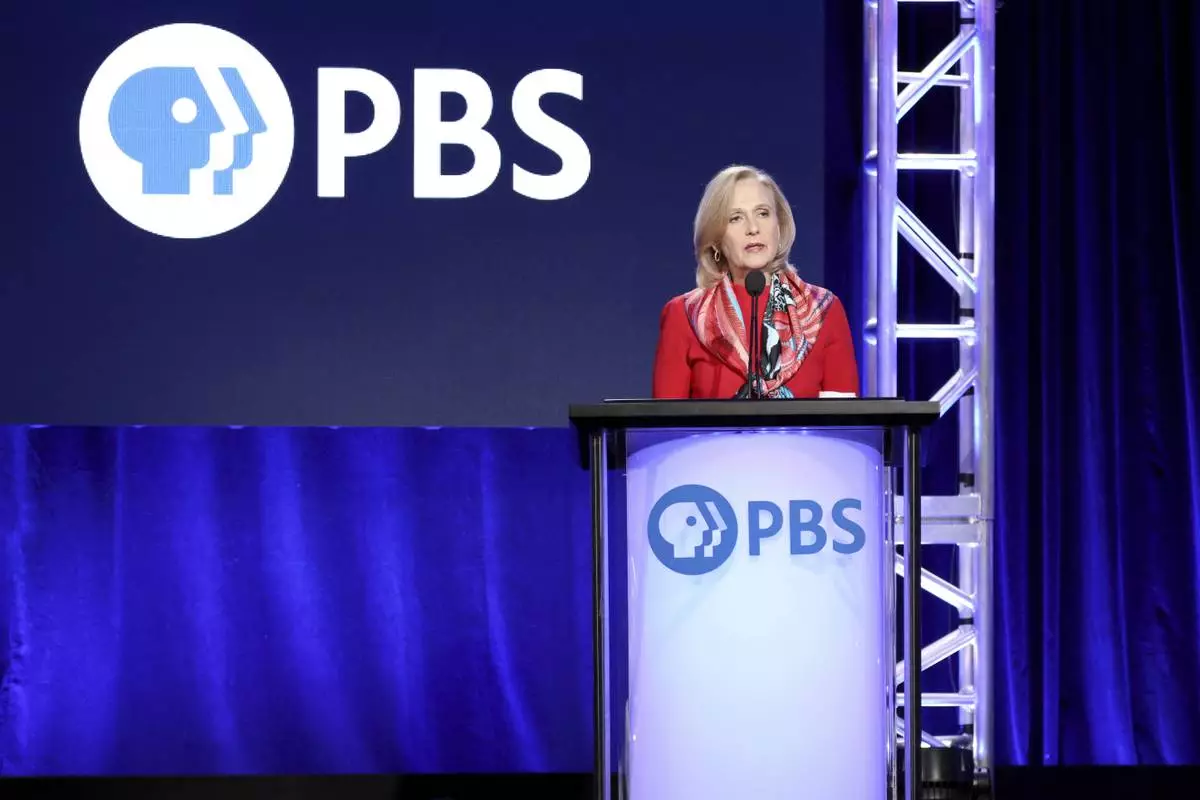
FILE - Paula Kerger, President and CEO at PBS, speaks at the executive session during the PBS Winter 2020 TCA Press Tour at The Langham Huntington, Pasadena, Jan. 10, 2020, in Pasadena, Calif. (Photo by Willy Sanjuan/Invision/AP, File)
























